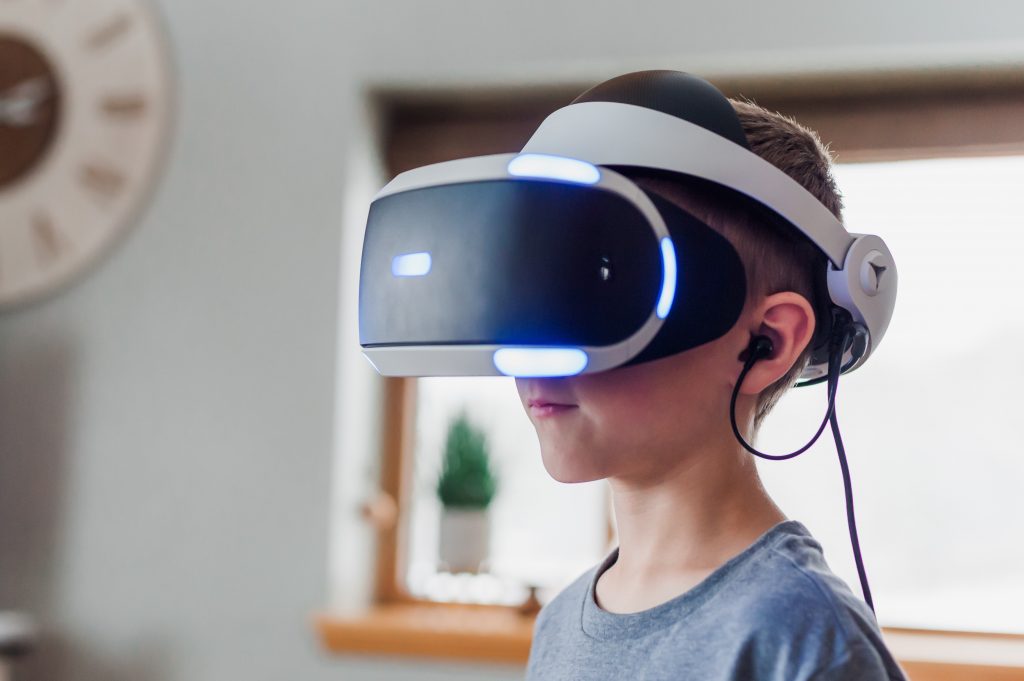
Developers and dreamers have been working to make virtual reality exactly that – a reality.
Oculus Rift, HTC VR Vive, Sony Playstation VR and other technologies available on the virtual reality market have been years in the making.
Introduction to the Virtual Reality Market
Improvements in technology have allowed for increased power, mobility, graphics, and decreased cost.
No longer do we have to plug into the likes of the Morton Heilig Sensorama – an arcade-style theatre cabinet that fully immersed the individual in the film by stimulating the user’s senses (sight, sound, smell, and touch included).
The international virtual reality market today has moved far beyond.
Here at Summa Linguae Technologies, we do data collection, localization, and testing of emerging tech devices. We dip our toes into the development process of various kinds of exciting technologies. One of those exciting technologies is VR.
Specifically, we worked on localizing a VR game from English to Chinese. We even spent some time in China as part of this data collection project.
While there, we became fascinated with how saturated the VR industry already is compared with North America and Europe.
It was this visit that inspired us to dive into the international virtual reality market.
Numbers Don’t Lie
The numbers don’t exactly tell the story of a hot new consumer tech debut.
By the end of 2016, less than 750,000 Playstation VR units were sold, even though various research groups had originally predicted 2.6 million units earlier in the year.
By comparison, Apple sold 3.3 million iPhones during the 6 months they were available in 2007 (the phone’s debut year). In 2008, sales rose to 11.4 million.
Clearly, the demand for VR products hasn’t been as high as initially anticipated – largely in part due to the expensive pricing.
Even though companies like Facebook-owned Oculus Rift slashing prices for that exact reason (the Rift is down by 25% from $800 to $600 as of March 2017), it’s easy to see how the public still might not want to take the $600 plunge.
However, mixed reality companies of various sizes, funding, and with unique mission statements continue to open up shop; all clearly concurring with Facebook’s $2 billion dollar bet on Oculus Rift.
As the market matures and competing companies gain attention from the masses, certain countries are pulling ahead.
Virtual Reality Market in China
Regardless of 2016’s less than anticipated sales for Playstation VR, Oculus Rift, and other tech-giant-sponsored VR endeavors, China’s market is picking up the pace.
Slashed Prices
In December 2016, Xiaomi, a Chinese electronics company headquartered in Beijing and famous for providing quality hardware at affordable prices, launched the Mi VR.
They sold out the first day. So did the second batch.
Needless to say, Xiaomi is hustling to scale their VR operations.
Like the Samsung Gear VR (which sold 2.3 million units in 2016), Mi VR requires a smartphone to use.
Perhaps the most exciting part of the Mi VR is the price tag of 119 Yuan, equivalent to just over $17 US dollars.
Though it doesn’t provide the same experience as a $799 USD HTC Vive, lower prices lead to higher adoption rates.
If you don’t know how to ride a bicycle, you would be more likely to buy a cheaper, more basic model versus a top-of-the-line road bike.
Then, once you decide you rather enjoy cycling and want to commit to an investment, you can.
Money, Money, Money
Other Chinese tech giants such as Tencent, Baidu, Alibaba and IQiyi have also begun introducing competing systems; all of which have the added benefit of cheap manufacturing power and large sums of money at their back.
Approximately 4 billion RMB ($593 million USD) was invested in VR in China in 2015 and 2016; a large majority funded by the Chinese government as part of their “Internet plus” initiative, aiming to transform traditional businesses and industries through digitization and new technologies.
Chinese President Xi Jinping considers VR a centrepiece of China’s growth.
HTC VIVE, world-renowned for their top of the line VR headsets, is teaming up with China National Tourism Administration.
They aim to support 200,000 offline travel stores across China to promote virtual reality as a new way of marketing.
“As the world’s largest travel market, China will now become the world’s first market to systematically apply VR technology to its tourism industry,” said Hongye Xin, Deputy Director of the Information Center, CNTA.
Needless to say, China is making huge steps towards truly integrating VR into every aspect of their day-to-day.
Perhaps soon we will see WeChat, China’s king of connected technologies, releasing a VR experience under their name.
Content is Key
Like with game consoles, smartphones, and any digital device you have ever come in contact with, content is king.
A VR headset would mean very little if you could not use it for anything. China has definitely keyed into this fact, and is moving its focus from hardware to content accordingly.
Hardware deals in China have decreased from 78% to 30% by August 2016.
“Currently VR headsets are not a must-have, but rather a good-to-have” says Junhan Ahn, COO of 87870 (a VR content platform based in Beijing).
“Investors are moving fast towards VR content investment. In China, there are about 3000 offline VR arcades and they need more content”.
Arcadia
While we were in China, we came across one of the aforementioned 3000 VR arcades; they have popped up in shopping malls all over the country.
You pay between 20 to 70 yuan for a session, depending on how long you want to be plugged in.
With high-quality VR headsets being so expensive, VR arcades could prove to be the perfect middle-ground for potential buyers to test out the product before committing to the cost.
This is reminiscent of the Internet Cafes of the 90s.
“VR arcades are a great exposure to high-end VR experiences that aren’t usually found in the home,” says Spencer Honeyman, creator of VirZoom. They make VR exercise bikes featured in a few of these VR arcades worldwide.
All of this results in devices which offer the same features, functionality and quality as their Western counterparts, at an accelerated rate.
In other words, China has a huge competitive advantage over the West. So much so, that it is estimated that the VR market alone could represent 55 billion Yuan by 2020.
North America: Silicon Valley
No article about the state of VR is complete without mentioning the mecca of technological innovation: Silicon Valley.
Challenge: Competitive Pricing
Silicon Valley is hard at work improving the technology in hopes of wider adoption; beyond those early enthusiasts who, despite creating buzz around the industry, are not your typical consumer.
That means creating high-quality products at lower costs (and hopefully one day, with lightweight and easily portable equipment).
Facebook CEO Mark Zuckerberg recently said he expects to spend $3 billion over the next decade to make VR more accessible.
That’s after his company bought Oculus for more than $2 billion.
One of the potential solutions that Intel, Microsoft, and Facebook are working on is a technology called “inside-out tracking.” This technology uses sensors built into a VR headset to track a wearer’s movements rather than relying on external equipment.
This removes the need to set up external cameras. You also don’t have to stay within a designated zone while using a VR device.
Intel’s Project Alloy, which made its debut at this year’s CES, is just one example of a headset that uses this technology. It also claims to add new tricks such as a “merged reality” feature.
Essentially, blending the wearer’s physical surroundings with a digital experience.
“When playing a game for example, Alloy could transform a nearby couch into a generator aboard an alien spaceship, preventing players from an accidental collision during gameplay without taking away from the virtual environment”.
Serious Venture Capital Funding
Silicon Valley is known for its deep pockets and wealth of tech startups making an impact.
Thus, it’s only natural that venture capital funding for virtual, augmented and mixed reality pools there.
In 2015 alone, AR/VR startups raised a total of $658 million in equity financing across 126 deals.
Of course, San Francisco-based venture capital firms such as Rothenberg Ventures, Boost VC, Y Combinator, and Andreesen Horowitz led the pack.
North America: Vancouver
Silicon Valley’s northern neighbor, Vancouver, is a fast-growing tech hub with the lofty title of one of the top 20 global cities in which to launch a startup.
With few immigration headaches, you can only imagine the kinds of world-class talent that flock to the city.
Over the past few years, I’ve noticed more and more mixed reality companies joining the tech community here; many of which differentiate themselves from the VR/AR tech giants by aiming towards more targeted industries (architecture, real estate, mechanics) that operate in parallel with mainstream markets (film, gaming).
Provincial Government Support
Similarly to China, the B.C. provincial government is making a clear effort to support the mixed reality industry.
“I think (virtual reality) is a key component in driving B.C.’s economy forward,” Creative B.C. CEO Prem Gill says. “It’s been noted in B.C.’s tech strategy, and we talk about it in our creative industries strategy as well. It’s interesting because there are a lot of clusters in the world right now exploring where [VR fits] in their ecosystem”.
In 2016, Creative B.C. invested $641,000 through its interactive fund in 14 different VR companies.
By July 2016, there were 168 mixed reality companies, and 5,500 full-time employees in B.C. alone, according to a report by DigiBC. Archiact is included on the list; the creators of popular VR mobile game series Lamper who received $3.2 million from Chinese company 37Games in return for a 10% share of the company.
As of February 22, 2017, the B.C. government also announced the expansion in eligibility for Interactive Digital Media Tax to include virtual and augmented reality products and companies; another progressive step towards the success of mixed reality.
Targeted Virtual Reality Markets
Dogu Taskiran, CEO of Stambol Studios, says that Vancouver in particular is destined to be a VR hub; both because of the prevalence of interactive entertainment studios and the talent Vancouver attracts.
Stambol Studios is a VR and AR company who creates marketing solutions with a focus on architecture and real estate.
Taskiran notes the VR market has not reached mass consumption for many reasons. But in the meantime, it has the potential to totally disrupt different spaces and industries.
“All of the immersive technologies are going to change marketing by a large margin,” he says, “more so than other industries”.
In real estate for example, VR allows buyers to literally walk through the buildings and experience their future home; to move furniture around, to paint the walls, and ultimately, to create an emotional connection with the space.
It goes far beyond simply looking at 2D floor plans or images from a few select angles.
“For companies building heavy machinery, you no longer have to organize a trip for your prospects to see what you’re building” Taskiran emphasizes. You can bring the experience to them.”
Virtual Reality Market in Europe
Europe’s virtual reality ecosystem now consists of nearly 300 companies, according to Venturebeat, and is quickly gaining in the battle for supremacy.
“The VR industry is booming and not just in the U.S. or Asia. The old continent has known a slower start, but definitely got up to speed during the past two years,” says Leen Segers, cofounder and CEO at LucidWeb, a French VR and WebVR consulting agency.
VR gaming takes the lion’s share of the ecosystem; the UK is producing the most companies across the VR board.
However there is activity around the continent, such as Switzerland’s Mindmaze, which has raised $100 million; Ireland’s Thrive Audio; and the Netherlands’ TheConstruct working with VR in the real estate industry.
Imax European Virtual Reality Market
In October 2016, IMAX announced their plan to open six VR pilot centers worldwide in the coming months; the first European VR center will open in Manchester, England.
The center will deliver “immersive, multi-dimensional VR experiences, including entertainment content and games,” IMAX said.
The “premium interactive content experiences” will range between 5 and 15 minutes in length.
Tickets will cost around £8-£10 ($9.85-$12.31).
Growing the Pie
Europe’s VR community is tight-knit and growing.
In 2015, there were 50 meet up groups with 17,000 members. By the end of 2016, that number had more than doubled; 138 VR meet ups sprouted up, and more than 38,000 people joined the ranks.
The multitude of mixed reality companies based throughout Europe seems more interested in growing the entire community side by side rather than as competitors; something which promotes fragmentation.
“In this early-stage industry it is about learning and sharing those learnings to ‘grow the whole pie’ instead of competing for pieces” says Daniel Doornink, founder and CEO at VRBASE (a VR incubator, accelerator, and studio based in Amsterdam).
euVR, an organization that aims to bring together the European VR community, is one such venture whose sole purpose is to ‘grow the pie’.
It is used as a discussion forum enabling the sharing of knowledge between all the different European VR hubs. It is also used as a database of the VR ecosystem in Europe.
“We are all in this together – in the competition of keeping Europe at the forefront of both openness and progressive thinking” says Olli Sinerma, Chairman and Founder of the Finnish Virtual Reality Association (FIVR).
These kinds of organizations have proven to increase landscape transparency, facilitate collaborations and partnerships not only within Europe, but internationally as well.
Virtual Reality Market Around The World
Ultimately, the virtual reality market will pick up and become a multi-billion dollar industry.
DigiCapital estimates the worldwide industry will hit a total value of $120 billion by 2020.
While North America undoubtedly leads in terms of venture capital funding, pure concentration of companies, and tech giants with mixed reality spin-offs, the Chinese market in particular is giving rise to many home grown innovations and competitors.


